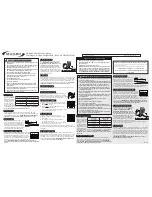
30
© 1998 SGC Inc
SGC Inc. SGC Building, 13737 S.E. 26th St. Bellevue, WA. 98005 USA
P.O.Box 3526, 98009 Fax: 425-746-6384 or 746-7173 Tel: 425- 746-6310 or 1-800-259 7331
E-mail: [email protected] Web site: http://www.sgcworld.com
Many users believe that just one IF stage (as in the SG-2020) pro-
vides inferior performance. Actually, the contrary is true. The less
IF stages there are, the less receiver and transmitter spurious fre-
quencies are apparent. Generally, if the design is done right, one IF
stage is suff i c i e n t . This also provides superior receiver perfor-
m a n c e . The SG-2020 receiver is equal or better than most trans-
ceivers available in the commercial or ham markets.
14.2 SSB TRANSMIT
The signal from the microphone is amplified by the VOGAD cir-
cuit. The gain is automatically set to the correct value, compensat-
ing for different microphones and voices. The audio is applied to a
balanced modulator and the resulting RF is limited which provides
speech processing. A wide range ALC circuit establishes the output
power level and further increases average power. Transmitter lin-
earity is the best in the industry with the special VOGAD system
providing signal transmission strength equivalent to much higher
100 watt transmitters.
14.3 CW TRANSMIT
When the key is closed, the microprocessor performs all the switch-
ing functions with appropriate delays to ensure smooth break-in
operation. A voltage is applied to unbalance the balanced modula-
tor and the BFO frequency is shifted 650 Hz to be inside the pass-
band. This creates a 60 MHz carrier with the correct frequency off-
set. From this point the CW and SSB signals follow the same path.
Also operating under microprocessor control are the sidetone and
keyer functions.
The IF and mixer are bi-directional, that is, the transmit signal pass-
es through the same stages in the reverse direction as the receive
signal. First the balance modulator, the IF amplifier, the crystal fil-
ter, a buffer amplifier and the mixer.
The remainder of the transmitter consists of four broadband gain
stages building the signal to 20 watts output. A bank of 6 low pass
filters eliminates harmonics and an SWR circuit provides signals for
the ALC and to the microprocessor for bargraph control.
Summary of Contents for SG-2020 TEST DOCUMENT
Page 1: ...S G 2020 Transceiver Installation and Operations Manual No Compromise Communications...
Page 54: ...50 1998 SGC Inc PROCESSOR PCB SCHEMATIC 1 OF 4...
Page 55: ...51 1998 SGC Inc PROCESSOR PCB SCHEMATIC 2 OF 4...
Page 56: ...1998 SGC Inc 52 PROCESSOR PCB SCHEMATIC 3 OF 4...
Page 57: ...53 1998 SGC Inc PROCESSOR PCB SCHEMATIC 4 OF 4...
Page 58: ...54 1998 SGC Inc LPA PCB SCHEMATIC 1 OF 3...
Page 59: ...55 1998 SGC Inc LPA PCB SCHEMATIC 2 OF 3...
Page 61: ...57 1998 SGC Inc EXCITER PCB SCHEMATIC 1 OF 8...
Page 62: ...58 1998 SGC Inc EXCITER PCB SCHEMATIC 2 OF 8...
Page 63: ...59 1998 SGC Inc EXCITER PCB SCHEMATIC 3 OF 8...
Page 64: ...60 1998 SGC Inc EXCITER PCB SCHEMATIC 4 OF 8...
Page 65: ...61 1998 SGC Inc EXCITER PCB SCHEMATIC 5 OF 8...
Page 66: ...62 1998 SGC Inc EXCITER PCB SCHEMATIC 6 OF 8 5R...
Page 67: ...63 1998 SGC Inc EXCITER PCB SCHEMATIC 7 OF 8...
Page 68: ...64 1998 SGC Inc EXCITER PCB SCHEMATIC 8 OF 8...
















































